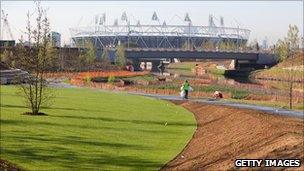London 2012: Olympic site transformed in tough times
- Published

The area has been transformed in the years since London won the bid
One year out from the Olympic Games, the Aquatics centre has become the last of the six main permanent Olympic Park venues to be completed under the Olympic Delivery Authority (ODA), the body responsible for building the venues and infrastructure.
ODA chief John Armitt outlines the remarkable change across the area.
As we reach the important milestone of one year until the start of the London 2012 Games, I can reflect proudly on what has been achieved by the ODA, our partners and contractors over the last five years.
The Olympic Park and the surrounding area is today unrecognisable as the site that was handed to us in 2007.
There are new world-class sports venues and new housing, thousands of trees and plants have been planted, the waterways have been dredged and widened, new bridges and roads have been built and there is a new backbone of utility and energy infrastructure.
And this has spread around the edges of the park, as new buildings, hotels, shops and housing are rising from the ground in Stratford. In short, the area has been transformed.
The distinctive Stadium lighting towers are clearly visible from Canary Wharf and the elegant curve of the Velodrome roof is glanced at by tens of thousands of people driving on the A12 every day.
But these are new landmarks on the skyline, and it is important to remember where we have come from and how much has been achieved, external to get us to where we are today.
Before we started work, the site was characterised by derelict land, industrial buildings and poor housing.
It was fragmented, polluted and divided by waterways, overhead pylons and railway lines with poor connectivity. Many parts of the area suffered from ground contamination, issues of poor water quality and inadequate sewage provision.
Before we could even start construction of the venues, we had to demolish more than 200 buildings, build underground tunnels and dismantle power lines, clear invasive species including knotweed, clean more than 800,000 cubic metres of soil weighing nearly two million tonnes, remove 70,000 tonnes of industrial and domestic waste from former landfill site and treat 20 million gallons of contaminated groundwater.
Construction has now been completed on the permanent new sports venues on the park, just over three years since construction began.
This project has created jobs and training at a critical time for the UK economy - around 40,000 people have worked on this project to date, and we have met our targets on employing and training local and previously unemployed people.
And it has also created opportunities for businesses with 98% of the ODA's 1,500 direct contracts going to UK businesses, worth £6bn.
At the start of the project we set out a 2-4-1 delivery timetable - 2 years to plan, 4 years to build, 1 year to test.
This was an ambitious target to finish a year ahead of the Games, and one which many people questioned if we would be able to meet. Indeed, we focussed on ensuring that there has never been any complacency.
But today, I am proud and happy to say that we are firmly on track to deliver on that promise and this has been achieved amid one of the toughest financial times on record.
We have proved to the world that UK plc can deliver big public projects on time and on budget.
- Published27 July 2011